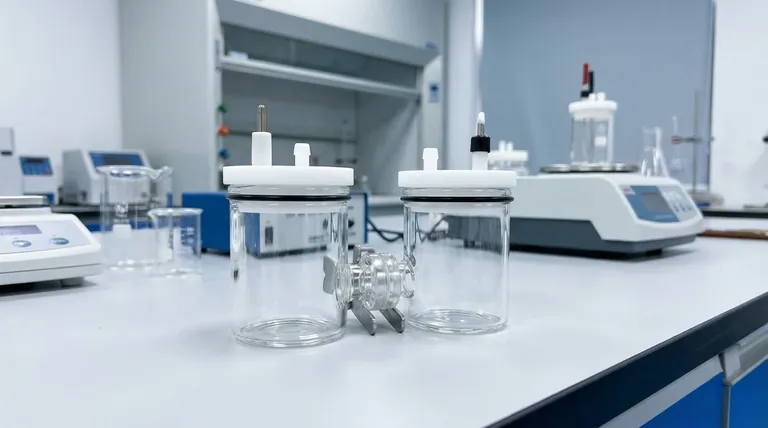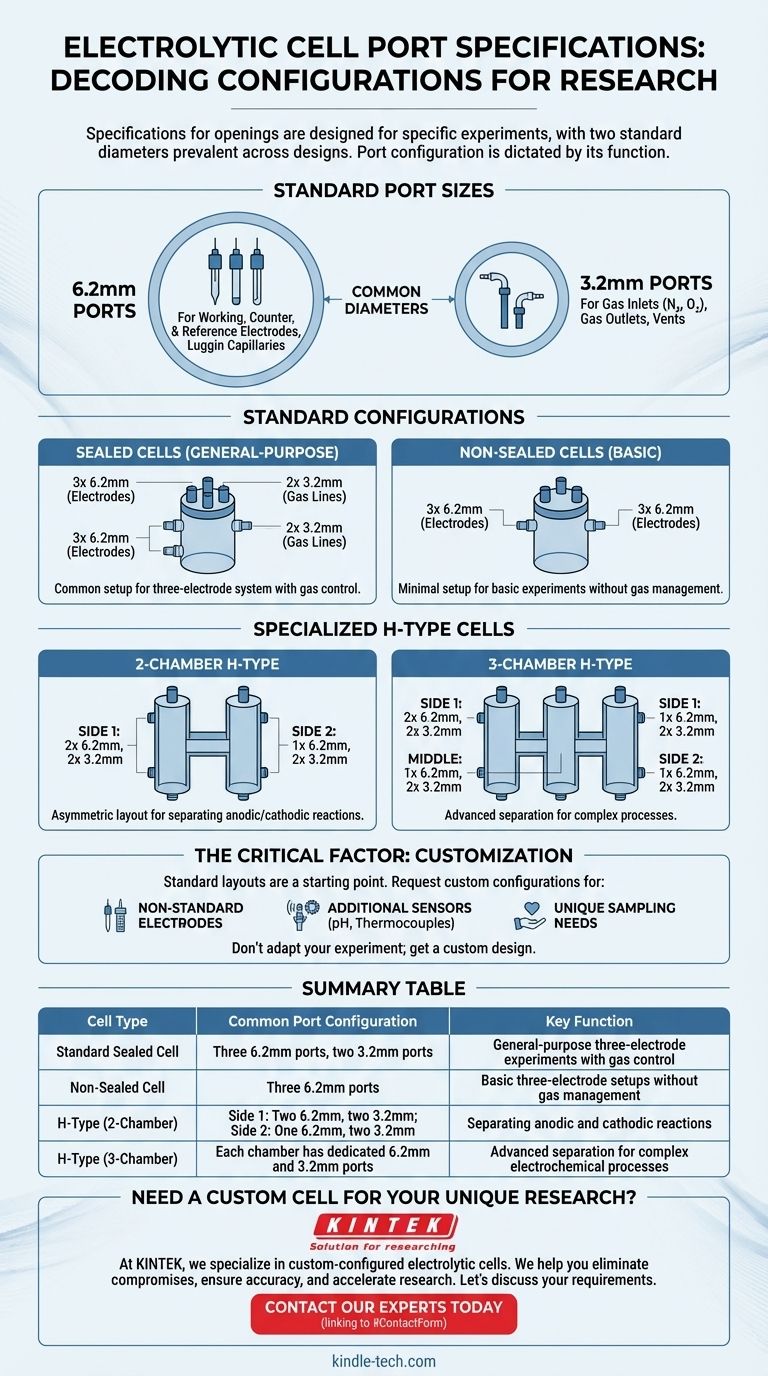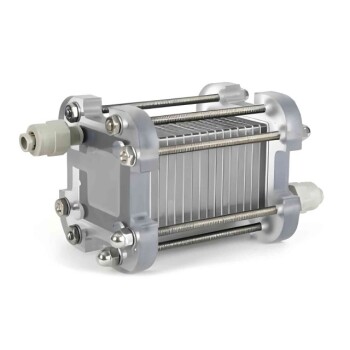The specifications for an electrolytic cell's openings are not universal, as they are designed to fit the specific type of cell and its intended experiment. However, two standard diameters are prevalent across most designs: 6.2mm ports are typically used for electrodes, while smaller 3.2mm ports are intended for gas inlets and outlets. The exact number and arrangement of these openings depend on whether the cell is a standard sealed model, an H-type, or a custom configuration.
The core principle to understand is that a cell's port configuration is dictated by its function. The number and size of openings are purposefully designed to accommodate the necessary components for a specific electrochemical setup, such as working electrodes, gas sparging lines, and reference electrodes.

Decoding Standard Port Configurations
To select the correct cell, you must first understand the purpose behind the common port sizes and layouts. The configuration is a direct reflection of the experimental requirements.
The Purpose of Each Port Size
The two most common aperture diameters serve distinct functions.
-
6.2mm Ports: This is the standard size for accommodating most working, counter, and reference electrodes. A typical setup requires at least three of these larger ports. Some designs also use this size for a Luggin capillary.
-
3.2mm Ports: These smaller openings are designed specifically for gas management. One is typically used as a gas inlet for sparging the electrolyte (e.g., with N₂ or O₂), while another serves as a gas outlet or vent.
Configuration for Standard Sealed Cells
A common "standard" configuration for a general-purpose sealed electrolytic cell consists of five total openings.
This setup usually includes three 6.2mm ports for the three-electrode system and two 3.2mm ports for managing the gas environment.
Configuration for Non-Sealed Cells
For simpler, non-sealed applications where gas control is not required, the configuration is often minimal.
These cells may feature just three 6.2mm ports to hold the essential electrodes.
Specialized Cell Types and Their Layouts
More complex experiments demand more intricate cell designs, such as the H-type cell, which separates the anodic and cathodic compartments. These feature more complex and asymmetric port layouts.
H-Type Exchangeable Membrane Cells
These two-chamber cells are designed to keep reaction products separate. As a result, the port configuration is not symmetrical.
One side is typically equipped with two 6.2mm electrode ports and two 3.2mm gas ports. The other side features one 6.2mm electrode port and two 3.2mm gas ports.
Three-Chamber H-Type Cells
For even greater separation and control, a three-chamber H-type cell adds a central compartment, with each chamber having its own set of ports.
- Side Chamber 1: Two 6.2mm electrode ports and two 3.2mm gas ports.
- Middle Chamber: One 6.2mm electrode port and two 3.2mm gas ports.
- Side Chamber 2: One 6.2mm electrode port and two 3.2mm gas ports.
The Critical Factor: Customization
A recurring theme across manufacturers and cell designs is the availability of custom configurations. Standard layouts are a starting point, not a rigid constraint.
Why Customization is Common
Standard configurations are designed for the most common experimental setups. However, electrochemistry is a diverse field, and researchers often use non-standard electrodes, require additional ports for sensors (like pH meters or thermocouples), or have unique sampling needs that a standard layout cannot accommodate.
When to Request Custom Specifications
Do not assume you must adapt your experiment to a standard cell. If your planned setup involves components that do not match the common 6.2mm or 3.2mm port sizes, or if you require more openings than a standard model provides, you should request a custom configuration from the supplier.
Matching the Cell to Your Experimental Needs
The choice of cell ultimately comes down to the specific components and processes your research requires. Use the following guidelines to make an informed decision.
- If your primary focus is a standard three-electrode experiment: A sealed cell with three 6.2mm electrode ports and two 3.2mm gas ports is the most common and versatile starting point.
- If your primary focus is separating anodic and cathodic processes: An H-type cell is necessary, and you must carefully verify that the port layout on each side matches the components you intend to use.
- If your primary focus is using non-standard equipment or sensors: Assume that customization is possible and contact the manufacturer with your specific component dimensions and requirements.
Ultimately, understanding the function behind each port is the key to selecting the correct cell for your research.
Summary Table:
| Cell Type | Common Port Configuration | Key Function |
|---|---|---|
| Standard Sealed Cell | Three 6.2mm ports, two 3.2mm ports | General-purpose three-electrode experiments with gas control |
| Non-Sealed Cell | Three 6.2mm ports | Basic three-electrode setups without gas management |
| H-Type (2-Chamber) | Side 1: Two 6.2mm, two 3.2mm; Side 2: One 6.2mm, two 3.2mm | Separating anodic and cathodic reactions |
| H-Type (3-Chamber) | Each chamber has dedicated 6.2mm and 3.2mm ports | Advanced separation for complex electrochemical processes |
Need a custom electrolytic cell for your unique research setup?
At KINTEK, we specialize in providing high-quality lab equipment, including custom-configured electrolytic cells. Whether your experiment requires non-standard port sizes, additional openings for specialized sensors, or a unique chamber layout, our team can design a solution that fits your exact specifications.
We help you:
- Eliminate Compromises: Get a cell designed for your components, not the other way around.
- Ensure Accuracy: Perfect port alignment for reliable electrodes and gas lines.
- Accelerate Research: Avoid setup delays with equipment built for your protocol.
Let's discuss your project requirements. Contact our experts today to get a custom quote!
Visual Guide

Related Products
- H Type Electrolytic Cell Triple Electrochemical Cell
- Electrolytic Electrochemical Cell with Five-Port
- H-Type Double-Layer Optical Electrolytic Electrochemical Cell with Water Bath
- Electrolytic Electrochemical Cell for Coating Evaluation
- PTFE Electrolytic Cell Electrochemical Cell Corrosion-Resistant Sealed and Non-Sealed
People Also Ask
- What experimental conditions need to be controlled when using an H-type electrolytic cell? Ensure Reliable and Repeatable Results
- What preparation steps are needed before starting an experiment with an H-type electrolytic cell? A Guide to Safe and Accurate Results
- What is the function of an H-type exchangeable membrane electrolytic cell? Master Precise Reaction Control
- What are the proper storage conditions for an H-type electrolytic cell? Ensure Long-Term Reliability and Accurate Results
- How should failures or malfunctions of an H-type electrolytic cell be handled? A Guide to Safe and Effective Troubleshooting



















